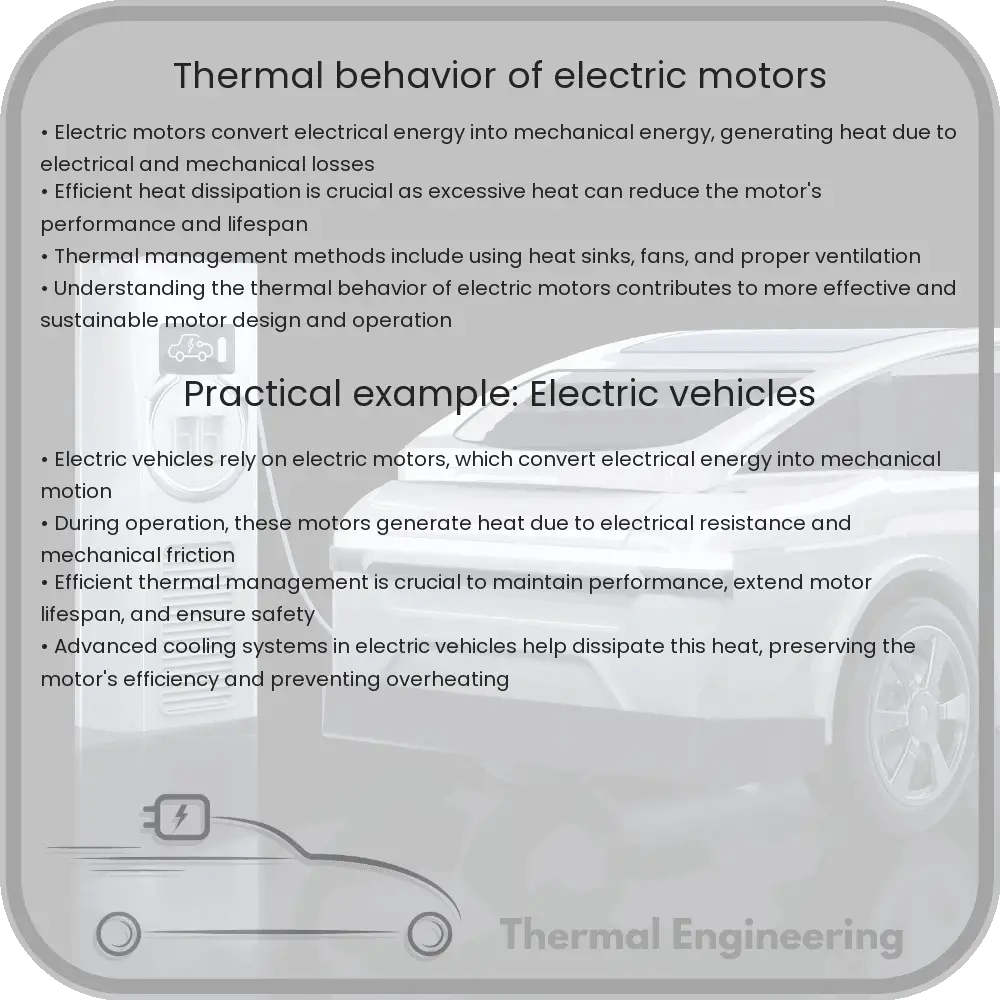Explore the impact of thermal behavior on electric motors, focusing on heat generation causes, issues from overheating, and effective thermal management strategies.

Understanding the Thermal Behavior of Electric Motors
Electric motors are instrumental in powering everything from household appliances to industrial machinery. However, one critical aspect that affects their efficiency and longevity is their thermal behavior. Overheating in electric motors can lead to reduced performance, failure, and even hazards. Let’s explore how thermal behavior impacts electric motors and the engineering principles used to manage heat generation.
Heat Generation in Electric Motors
Electric motors convert electrical energy into mechanical energy, but this process is not 100% efficient. Some of the electrical energy is invariably converted into heat. This heat generation is primarily due to three factors:
- Resistance Heating: As electric current flows through the motor windings, the natural resistance of the wire to the flow of current generates heat, known as I2R losses, where I is the current and R is the resistance.
- Iron Losses: These include hysteresis and eddy current losses in the motor’s iron core. Both are types of losses that occur from the magnetization and demagnetization of the core and from currents induced within the core by changing magnetic fields.
- Friction and Windage Losses: These are mechanical losses due to friction in bearings and other moving parts, as well as air resistance (windage) against rotating parts.
Effects of Excess Heat
When electric motors become too hot, several problems can arise:
- Reduced Efficiency: Increased temperatures lead to higher resistance (since resistance of conductors increases with temperature), which in turn causes more power loss in the form of heat.
- Insulation Breakdown: The insulation on winding wires can degrade or melt at high temperatures, leading to short circuits or failures.
- Lubricant Degradation: Excessive heat can cause lubricants in the bearings to degrade faster, which can result in increased friction and even more heat.
- Thermal Expansion: Different components of motors expand at different rates, which can misalign or deform parts and lead to additional wear or failure.
Thermal Management in Electric Motors
To mitigate these issues, effective thermal management strategies are essential. Here are some of the common methods used:
- Enhanced Air Flow: Many motors are equipped with fans or ventilated housings designed to improve air circulation, which helps in carrying the heat away from the motor.
- Heat Sinks and Cooling Fins: Some motors feature external heat sinks or cooling fins that increase the surface area available for heat dissipation.
- Materials Improvement: Using materials with higher thermal conductivities in motor construction can help spread and dissipate heat more effectively.
- Use of Temperature Sensors: Incorporating temperature sensors can help in monitoring motor temperatures and can trigger cooling mechanisms or shut the motor down to prevent overheating.
Advanced thermal management also involves thermal analysis during the design phase, using computational methods such as Finite Element Analysis (FEA) to predict hot spots and optimize the thermal properties of components.
Conclusion
Thermal behavior is a critical aspect of electric motor design and operation. Understanding and managing heat generation and dissipation ensures that motors operate efficiently, last longer, and are safer. Advances in materials science, cooling technologies, and predictive analysis continue to enhance the thermal management capabilities of electric motors, aligning with increasing demands for efficiency and durability in various applications.
Whether you are an engineer, a student, or simply a curious learner, appreciating these principles can provide deeper insights into the workings of electric motors and their applications in our daily lives.